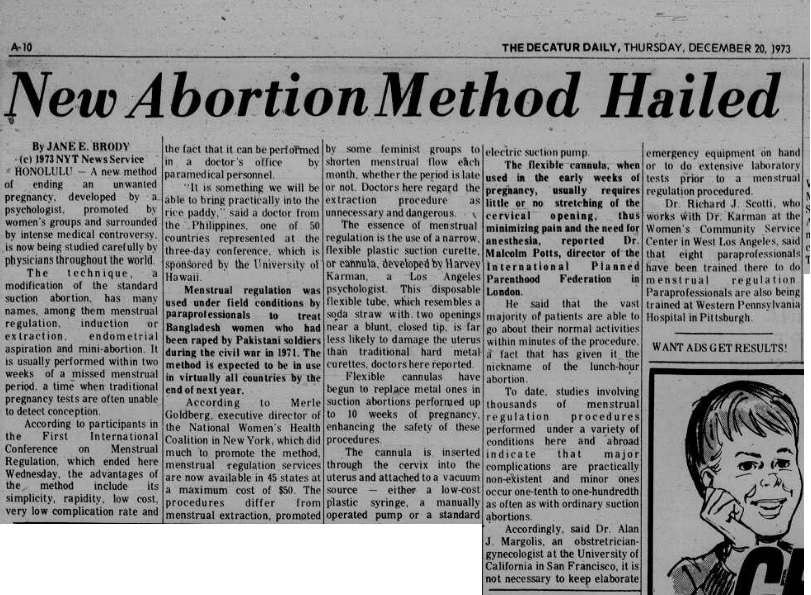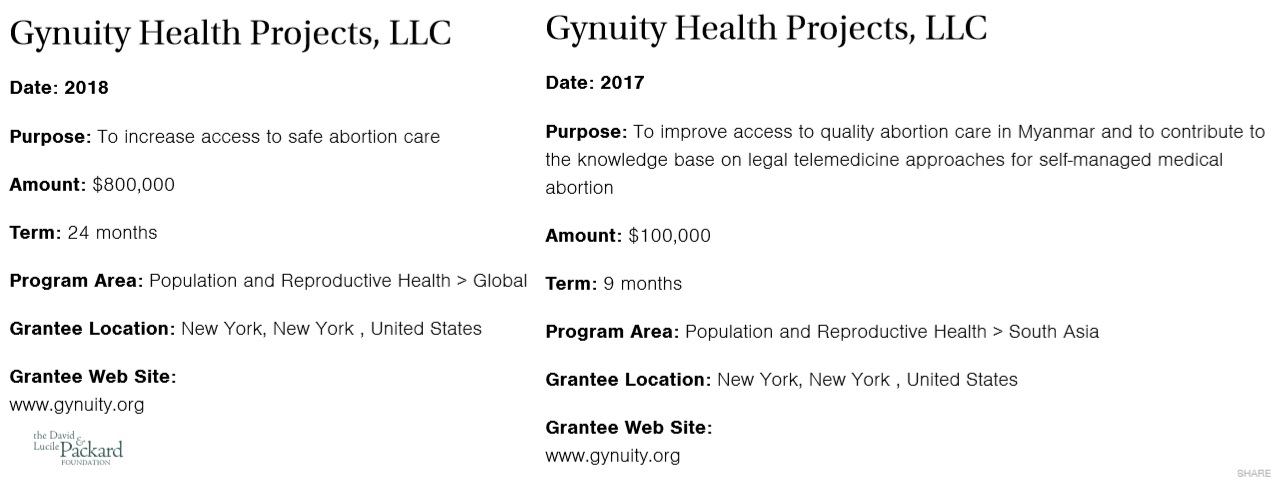In a new effort to expand the use of the abortion pill, a clinical trial will give women the abortion pill before they even have confirmed pregnancies. The so-dubbed “menstrual regulation (MR)” (or “menstrual extraction”) concept is not new; it has been around for decades since first promoted by Carol Downer, founder of the Feminist Women’s Health Centers. In 1972, Time Magazine described MR as a method “to terminate suspected pregnancies before conception has been confirmed,” because then, according to Time, “an abortion in fact is not an abortion officially.” The first menstrual regulation conference was held in 1973.
A footnote in a Guttmacher publication from the 1990’s makes it clear that “An abortion was defined as ‘any procedure, including menstrual extraction and menstrual regulation, intended to terminate a pregnancy,'” adding, “Some physicians use ‘menstrual extraction’ as a euphemism for early abortion.”
While on one hand, abortion advocates want women to “shout” their abortions, on the other, they hush it up by using euphemisms like “menstrual regulation” or “extraction,” and seem to want to avoid the idea of “abortion” altogether. The more things change, the more they stay the same….

Menstrual Regulation developed by Harvey Karman in 1970s
While original MR methods utilized a Harvey Karman cannula and a disposable flexible tube similar to manual uterine aspiration previously described at Live Action News, MR has gone through some changes. Self-managed abortion activists Francine Coeytaux and Victoria Nichols — who created the website PlanC to push dangerous home abortions — proposed MR using “pills” in a 2017 op-ed:
The history of menstrual regulation… began in California in 1971, when a group of self-help feminists developed a technique that allowed women to safely suction out menstrual blood and tissue. Referring to it as ME (menstrual extraction), these early self-helpers advocated that women join self-help groups and practice extracting each others’ menses around the time of their expected periods…
Menstrual Regulation quickie abortion
The article goes on to describe how “menstrual regulation” [using a vacuum aspirator to empty the uterus] has been tested in foreign countries such as Bangladesh where it was “[i]ntroduced in 1971 and defined as ‘the evacuation of the uterus of a woman at risk of being pregnant to ensure a state of nonpregnancy…'” The writers then laid out the case for several options in light of U.S. abortion restrictions:
- Plan A (contraception)
- Plan B (the morning-after pill)
- Plan C (misoprostol to bring down a missed period), and
- Access to safe abortion
They noted, “Finally, using misoprostol as a plan C would have the benefit of not having to label the process ‘an abortion.’ If a woman were to use misoprostol as a plan C, she would have the option to take the drug prior to even taking a pregnancy test. She would be taking precautions and could take the pill for menstrual regulation purposes. Not having knowledge of her pregnancy status could free her from guilt or self-stigmatization that she might otherwise face.”
Despite the hype that MR is not an abortion, global pro-abortion organizations like IPAS openly acknowledge that it is:

IPAS refers to Menstrual Regulation as an abortion (Image: Twitter)
Medical Menstrual Regulation (MMR)
Today’s Gynuity Health Projects-sponsored clinical trial method is called “Medical menstrual regulation (MMR)” and is set up to dispense the abortion pill regimen (Misoprostol and Mifepristone) to women who report a late period without determining pregnancy first. The newly dubbed method is described by Gynuity as:
… the use of uterine evacuation medications by women with late menses without confirming pregnancy status. Provision of MMR in the United States could expand reproductive choice and service options for women. This study will collect data on the acceptability, efficacy, safety and feasibility of MMR among women with missed menses of 1-3 weeks.

Menstrual Regulation pushed by Gynuity on (Image: Twitter)
Gynuity has been funded by organizations known for their support of abortion and population control, including funding from abortion pill manufacturer DANCO‘s original investor, the David and Lucile Packard Foundation — leaving many to question whether the results of these clinical trials can be trusted.
- Packard seeded DANCO with millions of dollars as it transitioned from the Population Council to DANCO Laboratories, LLC.
- Packard’s investment included a $14 million loan as early as 1996 to bring the drug to the U.S.
- Packard’s 990s for 2000, 2001, 2002, 2004, 2007, 2008, and 2009 show ongoing support for DANCO.
In addition, the Gynuity experiments will take place at Packard-funded Carafem abortion facilities in Illinois and Maryland where they will be monitored by Gynuity’s Principal Investigator: Wendy R Sheldon, PhD.

Gynuity funded by population control organizations
Interestingly, Packard’s money trail to Gynuity on their own website appears to have been mysteriously scrubbed, but remains online in a cached version (images below):

Gynuity Health funded by abortion pill investor Packard 2017 and 2018
Gynuity’s history with Packard and other abortion insiders runs deep:
- Founded by Beverly Winikoff, M.D., M.P.H, who was previously employed at the Population Council, which brought the abortion pill into the U.S. and set up the pill’s manufacturer, DANCO. She served on the board of the National Abortion Federation.
- Gynuity’s Senior Clinical Adviser Paul Blumenthal served as a member of the Board of Directors of the National Abortion Federation (NAF).
- Worked to expand abortion, and it conducts abortion pill clinical trials, such as the effort to expand TelAbortion
Tragically, women have died from this deadly abortion pill regimen. Women who experience medication abortion are beginning to warn others that it is not as simple and painless as it has been sold:
Live Action News has been documenting the abortion industry’s clever work-around efforts surrounding the abortion pill to evade safety requirements put in place by the FDA, known as REMS. We have also identified abortion pill collaborators like The Packard Foundation, and revealing the behind-the-scenes close connections between various clinical trials, studies (read more here) and funding streams. In addition, Live Action News has documented the push for illegal dispensing of the dangerous pills and the effort to discredit abortion pill reversal.
Editor’s Note: FDA has received reports of serious adverse events in women who took mifepristone. As of June 30, 2021, there were reports of 26 deaths of women associated with mifepristone since the product was approved in September 2000, including two cases of ectopic pregnancy (a pregnancy located outside the womb, such as in the fallopian tubes) resulting in death; and several cases of severe systemic infection (also called sepsis), including some that were fatal. The adverse events cannot with certainty be causally attributed to mifepristone because of concurrent use of other drugs, other medical or surgical treatments, co-existing medical conditions, and information gaps about patient health status and clinical management of the patient. A summary report of adverse events that reflects data through June 30, 2021 is here.
“Like” Live Action News on Facebook for more pro-life news and commentary!








